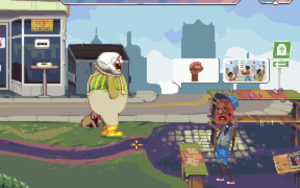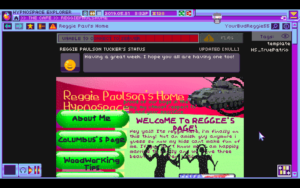Dropsy: Last Words and Lack Thereof
The story in Dropsy develops a split tone as it progresses. On the one hand, the clown is off having fanciful adventures with his animal friends, bringing happiness to every stranger he meets. But at the same time, his friend’s health just continues to deteriorate, and there isn’t much he can do about it. A miracle cure stolen from the laboratory of a wealthy corporation just ends up not doing anything, and possibly making things worse. For a time, it seemed possible that the game would actually let him die. It would certainly fit the work’s themes. Several of the NPCs you help are suffering from similar loss. The very first mission was to visit a grave. Ending the same way would be a neat little bit of design.
But that’s not the direction the author chose. Instead, he introduces a villain: the head of the aforementioned wealthy corporation.
Struggling against villainy is kind of against the ethos of the game so far, and so that isn’t what you do. This villain is a deceiver, and the clown is easily deceived. He approaches you with a deal: “I’ll take care of your friend, give him state-of-the-art medical care, if you come work for me. I’m setting up a circus of my own — a bigger, better one than the one you used to work for, and I’d really love for you to be our star attraction.” (I’m paraphrasing. Like everyone else in the game, he speaks entirely in images.) To the player, this is offer is immediately recognizable as mephistophelean. The mere fact that there’s no obvious downside is a clear indication that the downside is something he’s not telling us about.
I won’t go into detail about the ending, but I’ll note that it confirms some suspicions about the clown. Past a certain point, you’re basically guided through a linear series of rooms, with the “save game” functionality disabled so you can’t accidentally overwrite your last opportunity to complete side-quests. (And good thing, too. There are still a few citizens that I haven’t figured out how to make happy.) Most of these rooms are ones which you’ve seen before, but with some additional context that ties together things that didn’t seem important previously. As someone who comes from a text adventure background, I’m well aware of the things that text can do more easily than graphics, but it strikes me that the narrative techniques on display here, of environmental details that fade into the background when you don’t have the context to understand them but assume greater importance later, are a form of storytelling more easily done in graphics than in text, where it’s nearly impossible to show the reader something without drawing their attention to it.
But then, maybe I’m just obtuse. There are definitely things in this game that I didn’t understand when I was supposed to. Like what the hug icon was. Replaying the beginning a little, I found that the game attempted to tutorialize it by making you use it on the clown’s friend, but this wasn’t enough for me. Also, there were several puzzles where I didn’t understand what I was trying to accomplish (beyond just solving a puzzle for puzzle-solving’s sake) until afterward. On the story side, one thing I learned from the late-game revelations is that the character I’ve been calling the “friend” in fact raised the clown from when he was a little clown baby. Was I supposed to have been reading their relationship as father-son all along?
Then there’s the matter of the fire. This is part of the backstory established in the intro cutscene. The reason the clown is a free agent through most of the game is that there was a terrible fire in his circus, which killed several people. We see the fire start, and the clown’s dismayed and horrified reaction. Then, in the game, we find out that the clown was blamed for the fire, and demonized for it in the press. This is part of the reason he has to work so hard to get people to trust him. My assumption from the beginning, based partly on what I saw in the intro and partly on thematic resonance with Hypnospace Outlaw, is that he was blamed unfairly. But a dream sequence suggests that he feels real guilt over what happened. Was he in fact in some way responsible? I don’t believe for a minute that he set the fire deliberately, but it’s quite plausible that he could have started it through accident or negligence. The game, as far as I can tell, doesn’t provide a definitive answer. But I’m not sure if it’s being deliberately ambiguous or just failing to communicate clearly without words.
One last thing I’ll note: the name of the clown. The clown is named Dropsy, probably because of his distressingly swollen and squishy appearance. But I’ve been taking meticulous care not to refer to him by that name, because it didn’t seem to be established anywhere in the game — sure, it’s the game’s title, but what does that show? I remember once overhearing some people in an arcade arguing about whether the title of the classic Sega coin-op game Shinobi referred to the player character or the end boss. (In a sense they were both right: “shinobi” is just a synonym for “ninja”. But this was not common knowledge at the time.) But it turns out that the clown’s name is established in the descriptions of the Steam achievements, for example, “Furry Friend: Dropsy rescues a new friend from peril” or “Clownographer: Dropsy explores the whole entire world.” Now, I personally like to treat adventure games in particular as self-contained, and reject out-of-band information, at least while playing, because once you seek additional information online, you open yourself to puzzle spoilers. Do achievement descriptions count as out-of-band? I suppose they’re in the same nature as a printed manual: not part of the game per se, but canon nonetheless.
But now that I’ve finished the game (at least in the sense of reaching the ending, if not in the more important sense of befriending absolutely everyone in the world), I’ve looked at the guides a little, and learned that what I had dismissed as “meaningless squiggles” is actually a substitution cipher. So maybe the ambiguities and lacunae I’ve noted would be resolved for the meticulous player. It’s a little strange to me that I didn’t even think of trying to translate them myself, especially coming straight off Heaven’s Vault. Certainly I eagerly solved the ciphers in Fez and Gloomhaven. I suppose the difference is that those games seemed more challenge-oriented. When you come across runes there, it’s just another thing for you to overcome. Whereas in Dropsy, as I’ve noted, it seemed more like a way to establish your illiteracy. That makes the player’s attempts at deciphering it seem inappropriately out of character. It does explain why several scenes let you zoom into closeups of what I had taken to be unreadable text, but I had taken that to be a gag similar to what it does with telephones: when you try to press their buttons, your handless stubs of arms just mash random groups of buttons uselessly.
 Comments(0)
Comments(0)
